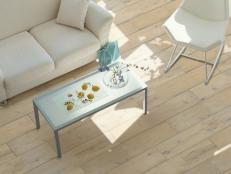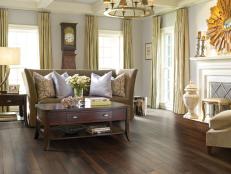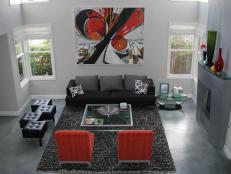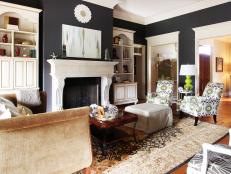Top Living Room Flooring Options
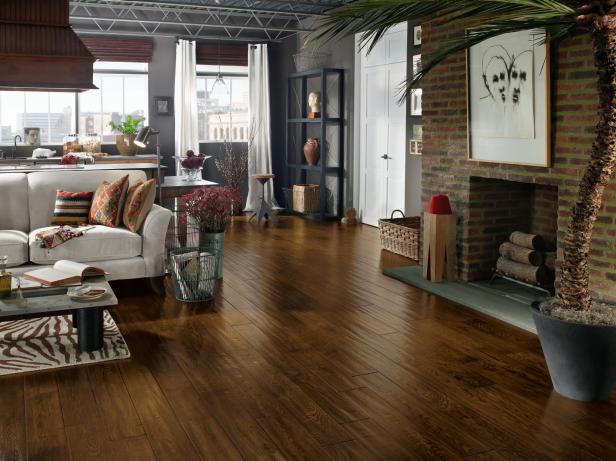
Before a room can be decorated, furnished or even just moved into, it must have a substantial floor. When chosen with care, the best flooring options will set the stage for many years of good looks, durability and comfort.
When selecting flooring, a little homework goes a long way. You'll want to take into account the style of the house, the budget, the amount of wear-and-tear you anticipate it will need to withstand, and the look and feel you want to create. From standard wood flooring to stone or concrete, living room flooring options are plentiful and offer a range of pros and cons.
Architect Bob Wetmore of Cornerstone Architects says that as styles evolve, so do our options. "With the developing soft contemporary movement, we frequently design stained concrete floors or a clean-engineered wood floor," he says. "We also enjoy using cork floors that are very resilient to walk on and warm on the feet during the winter."
One of the benefits of working with a trusted architect or contractor is that he or she can quickly help you narrow down your options. But whether you're going it alone or enlisting in the services of a professional, experts agree upon one thing: Don't make a decision based on a small sample in a showroom. See how it looks on a grander scale.
"Compare samples side by side and to try to see the product in an actual installation," says architect Robert Tuthill. "Seeing a floor as a complete composite is sometimes much different than how it appears as a small sample."
And then, of course, once you've chosen the materials, proper installation is key. A firm, stable, substantial floor should feel that way. In living rooms in particular, a decorative rug will likely anchor the furnishings, but the flooring materials are the foundation that the rest of the room depends upon.
Here are the pros and cons for the most popular living room flooring options.
Wood
When remodeling an older home, good fortune sometime smiles upon those brave enough to pull back a corner of a tattered old carpet: There might be pristine hardwoods underneath, which often can be sanded, stained and sealed. With plenty of choices in stain color, the floor and the room as a whole can feel remarkably refreshed, polished and updated with minimal effort and expense. No large crews of workers, no shopping for expensive materials. It can be incredibly satisfying to do so much with so little.
But what if your hardwood floors have damage or need to be extended? A practical and economical option is to match them. "Make use of what you have," advises architect Carol Sundstrom. "If you already have hardwood, consider matching and refinishing. I prefer large continuous areas of one material rather than a different flooring material in each room, which reminds me of a patchwork quilt."
And if you need to start from scratch, you can broaden your horizons a bit. There are hardwood options that can be fitted into your space while bringing a sense of age and patina. "We love the warmth of reclaimed heart-pine flooring," says Jane Frederick, of Frederick + Frederick Architects. "It is sustainable because it is reused from old beams removed from buildings being torn down. The boards are wide — 8 inches to 12 inches — and the patina is wonderful."
Hardwood Floors
See All PhotosCarpeting
Though wall-to-wall carpeting in bedrooms is still a popular choice, in living rooms, not so much. "I generally never use wall-to-wall carpet in high-traffic or public areas unless my client specifically asks for it," says designer Rachel Oliver. "It is usually less expensive than hardwoods and many styles are easy to keep clean, but it can soak up odors and liquids in high-traffic areas and may stain."
Oliver, however, has a trick for taking advantage of the cozy feel that wall-to-wall carpeting provides: In addition to the rugs she likes to scatter about a space, she sometimes has carpeting cut and bound to the exact size needed for a room — it provides all the comfort of carpeting but can be easily removed and cleaned or swapped out.
As for getting the size just right, Oliver recommends floating a large carpet 12 to 24 inches from the perimeter of the room. "It offers a uniform, clean look," she says.
"The right rug can offer a high-end look in any home, no matter the price," she says. "There are even many indoor/outdoor rugs that are soft enough for babies and kids to play on. Natural jute, seagrass and sisal rugs are hugely popular, but can be harsh on bare feet."
Stone
"Stone has a strong, tailored feel that tends to work in public spaces," says Robert Tuthill. Stone flooring is not only desirable for certain architectural styles (think grand Old World rooms or spacious modern expanses), it can be entirely appropriate and elegant and, in some cases, relatively locally sourced. With its natural tones and unique characteristics formed eons ago under the surface of the earth, stone flooring can be a sophisticated, one-of-a-kind and very durable option. It can also be one of the more costly options.
Using natural stone, such as marble, slate, travertine or limestone, will require careful installation. Cracking, chipping and staining can be some of the pitfalls if the area is not carefully prepped, depending on the type of stone used. Remember, stone flooring will be cool in warm climates and downright chilly in cold climates.
Concrete
Minimalism and the appeal of industrial-chic options make the use of concrete a surprisingly popular option for indoor living spaces, where concrete flooring has moved beyond the garage and into the house. Painting, staining, scoring and polishing — just a few of the options available — enable an existing concrete slab to be transformed rather dramatically while also fairly cost-effectively. These floors can withstand just about anything, but the reverse is also true: Not much can withstand them. If you drop something on a concrete floor, chances are it will suffer. There's no give in this material, but in living rooms, where we're not often on our feet, it might not be such a concern.
Also, "concrete floors, by nature, reflect sound," says Bob Wetmore, who advises that the placement of rugs and sound-absorbing materials such as drapery and furniture should be carefully considered. "But the pros for concrete floors are their durability and practicality. Using the right sealers, they generally only require a damp mop to clean."
Whether you choose the warmth and patina of hardwoods, the elegance of stone, the modernity of concrete, or another type of floor that speaks to you and the architecture of your home, weigh the pros and cons and get expert advice. And in the end, if you make a choice you regret, throw a rug over it. Chances are, you were going to do that anyway.







